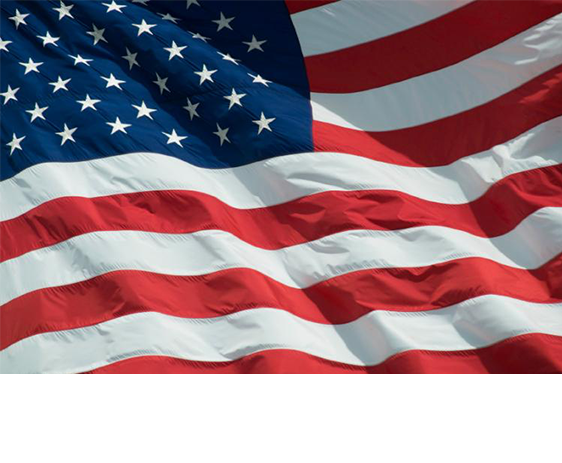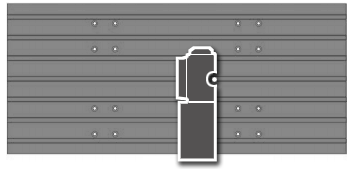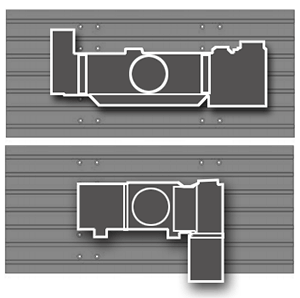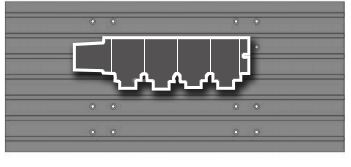Aircraft Engineering Takes Flight
Get Me a Contract and I’ll Buy a Machine to Do It!
Back before the onslaught of big-time mergers, buyouts and corporate downsizing, the cart often came before the horse with regard to procuring aerospace contracts. Shops would bid jobs for the major manufacturers without necessarily having the machinery on hand to make the parts. Only after eliminating the competition and securing the job would they purchase the equipment necessary to fulfill the contract.
In today’s world, things are different. As more shops enter the fray for a slice of the aerospace pie, manufacturers like Boeing, McDonnell Douglas and Martin Marietta are looking for suppliers that already have the capacity and capability to do the work. No longer are they willing to wait months – or even years – for their parts.
This fact has become the driving force behind Aircraft Engineering Corporation (AEC) of Paramount, California. Over the past year and a half they have added nine vertical machining centres from Haas Automation, to their equipment list, including three VR-11 five-axis profiling VMCs.
Additional Haas machines are scheduled for arrival early in 1998. They are determined to have the machines on the floor to handle any job that comes their way.
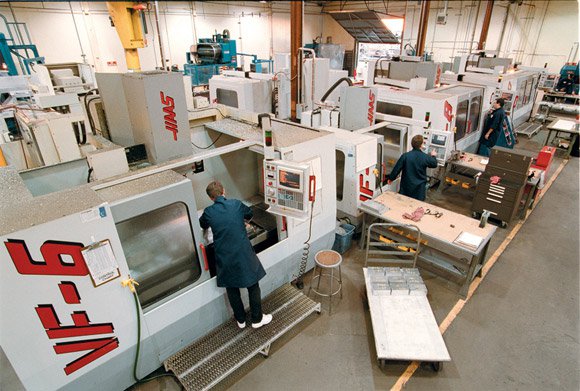
“The mentality used to be: Get me a contract and I’ll buy a machine to do it,” explains Cliff Kenney, AEC’s procurement manager. “Now, if you don’t have the machines on the floor ready to rock and roll, you don’t get the contract. So, either you’re staffed and ready to run, or you’re not going to get the work.”
AEC has been a major supplier to the aerospace industry since 1959. For most of those 39 years, they’ve been known primarily as a tooling house: building aircraft assembly tools, fixtures and ground support systems for the major manufacturers. But tooling is typically a one-shot deal – once the tools are made, the job is done. Additional tooling is usually unnecessary until a new aircraft design is ready for implementation.
For years defense contracts provided a steady flow of work for AEC and a myriad of other aerospace shops. There was enough work for everyone as defense spending ballooned to record highs. But it couldn’t last forever. Fed up with the American government’s spending us all into recession in the name of national defense, the public called for cutbacks. Many shops closed their doors forever as the flow of defense work slowed to a trickle.
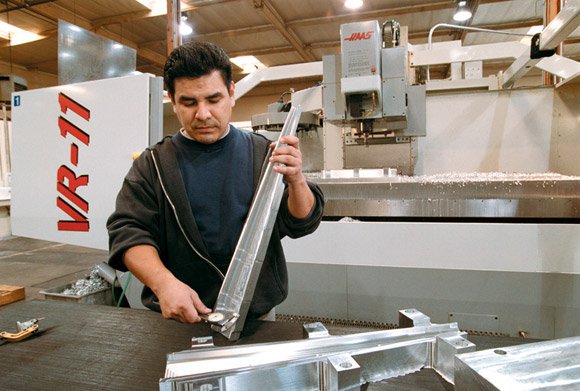
AEC was one of the shops to successfully survive the ensuing lean years, and thus was able to capitalize on the next aerospace boom: commercial aircraft. An improving economy, combined with aging planes reaching the end of their operational life, saw airlines once again investing in new fleets.
Unfortunately, most of the commercial aircraft being built were based on existing designs, so there was little call for new tooling. There was, however, a demand for production airframe parts and new tooling. With the number of suppliers seriously reduced by the previous slump, there were now more contracts than suppliers to fill them.
AEC decided to take advantage of this tremendous potential by diversifying their operation and manufacturing production airframe parts to supplement their tooling. According to Kenney, this idea had been kicked around for years, although AEC initially tried to stay out of production work. “A lot of customers don’t like to mix their tooling with their production parts,” he explained. “If you do tooling, that’s all they’re going to give you; if you do production, that’s all they’re going to give you. They’re typically not going to give you both.”
But in today’s economic climate, it can be tough to find good suppliers, so corporate buyers tend to stick with vendors they already know. AEC’s years of experience and reputation in the industry allowed them to break through the tooling/production barrier and utilize their existing customer base for both types of work. “We’ve been around a long time,” Kenney said. “They know who we are and what we’re capable of, so they want us to do the work.”
Up to that point, only about 5% of AEC’s work had been production. “We were running some production parts, but very limited,” notes Bob Jeppesen, AEC’s marketing manager. “Our big concern was that, if we were going to get into the production atmosphere and get real serious about it, we had to get into high speed [machining].” If AEC wanted to increase their percentage of production machining, it was obvious they would need to invest in more – and faster – equipment.
According to Kenney, “Speed doesn’t buy you much in tooling, because you’re talking one part. By the time you get the bugs worked out so you can run it up to high rpm, you’re done.” But production parts are usually machined in large batches, so high speed and reduced cycle times are required to keep the price per part competitive. “We knew we couldn’t run the parts fast enough on our old machines,” Kenney said. “They just wouldn’t cut it. It was obvious we had to do something.”
AEC looked at a lot of different manufacturers before deciding to invest in Haas CNC machines. Price, availability, high speed and service were some of the key factors in their decision. “We knew we were going to add some machines,” Kenney explained, “and I didn’t want to be dependent on Japan or the East Coast for parts and service. I don’t want to go to Mecca, I want Mecca to come to me. Haas made that a lot easier.”
A heavy influx of orders for production parts soon necessitated that AEC quickly add equipment to their machine arsenal. They purchased their first Haas machine – a VF-6 with 64″ x 32″ x 30″ travels – in June of 1996, and have since added a VF-1, a VF-3 with Haas Automatic Pallet Changer, a VF-7, a VF-8, a VF-10 and three (3) VR-11 five-axis profiling VMCs. Five more machines are scheduled for delivery in 1998.
For added flexibility, most of AEC’s Haas machines are equipped with high-torque 10,000-rpm spindles, expanded memory, probe-ready packages, 1,000 block/second processors, and 4th- and 5th-axis controls. “We have them all set up so we can do anything with them,” Kenney said. “We learned a long time ago that it’s cheaper to buy features now than try to retrofit them later.”
Kenney reflected that, “With some of the other manufacturers, you can’t get delivery on big, heavy machines for 14-16 months. We couldn’t wait. You have to machine parts when the orders are there, or you lose out. We knew how long it would take us to run the parts on our existing equipment, and we knew we had to do it faster if we wanted to be in a competitive position in the marketplace. The Haas machines have put us in the right place.”
But being in the right place means more than just having machines on the floor. It means having the right machines, and having them up and running. “When we have a Haas roll in the door, we figure it’s going to be online in a week,” Kenney said. “If we bring a VF-10 in here on Tuesday, it will be up and running Friday. And, the availability of parts and the service staff are excellent.”
Jeppesen added, “We have machines right now that, when we get in a bind for replacement parts, we have go to Japan for them. Even expediting them and express shipping everything, you still lose a week. And if it’s an older machine, it’s going to take you months. If you’re not making deliveries, you don’t get any more orders. They don’t care what kind of equipment you have. You’re out of business.”
At present, about 50% of AEC’s business is machining production airframe parts, and that percentage is increasing. Their goal is to position themselves as a “first-call” supplier for major manufacturers such as Boeing and Lockheed/Martin. To this end, they are buying machines with larger travels and certifying their accuracy.
“Any mom and pop shop can buy a smaller machine like the VF-1 or VF-2,” Kenney explains, “but they don’t have the funds to buy the larger VF-6s, 7s, 8s and 10s. So, we’re trying to keep more of our machines in that higher end of what Haas has to offer. A lot of other manufacturers don’t have the length, the X travel. Haas has the length. We’ve got those 120-inch VF-10s and VR-11s, and we can run a long part that nobody else can really run in a timely manner.
“We’ve run parts over ten feet long in our VF-10,” Kenney continued. “We leave the door open, run it out the door and shift it. They’ve enabled us to get more work.”
With the larger machines on the floor, AEC has been able to get work that some of the smaller shops can’t do. But getting the work and meeting production schedules doesn’t mean a thing if the parts aren’t accurate.
“One of the things we’re working on,” Kenney said, “is buying the parts directly off the machine. Right now, the parts go from machining to quality control, where they’re inspected 100%. By using probe systems and in-process inspection, we hope to reduce much of the inspection process. We won’t eliminate it all – the part still has to be inspected – but we won’t have to touch every dimension, every hole,” Kenney said. “There aren’t many people in the world who are certified to do that for Boeing, and we’re close.”
Since Boeing is one of their primary customers, AEC is in the process of qualifying their Haas machines in compliance with Boeing’s ATA standards (a set of standards used to determine the level of accuracy and repeatability achievable by a particular machine at a particular supplier). Consisting primarily of a ball bar test, laser calibration of the machine and a test plate, these standards determine the level of work – i.e., very critical, critical, etc. – Boeing will release to a certain supplier.
AEC’s SPC Administrator Werner Van Raay: “What’s most important here isn’t the laser cal, or the ball bar or any of the other tests, it’s the plate. Because that plate is going to establish where you are on Boeing’s scale, as far as accuracy and capability. The test plate is the thing that says, ‘This is what you’re qualified to do.’ The tighter the tolerance on the plate, the higher you get on Boeing’s list. I want to put as many machines as I can out there, so that when they look at our list they say, ‘Okay, this is their capability, and man, look at all the machines they’ve got.’” At present, AEC has qualified four of their nine Haas machines for ATA; two more should be qualified by next month.
“We want to really know what the capabilities of the machines are, so that we can reduce inspection, make parts a little faster and know that the parts are right,” Van Raay remarked. “As far as the Haas machines go, they’re extremely accurate. We even had one Haas that pointed out problems with our CMM. We had a test plate off the VF-6 that kept showing a pattern that was out of square. We called Haas, and they checked the machine and proved it was in square. We kept checking and it turned out to be the CMM – it had settled on the foundation and was out of square.”
This type of accuracy, as well as high speed, are the necessary ingredients for successful production manufacturing in the aerospace industry. AEC has been able to slash their cycle times and meet the high production rates and quality levels required by their customers.
By adding Haas CNC machines to their stable of equipment, Aircraft Engineering Corporation has decidedly put the horse back where it belongs – in front of the cart. Having the machines on the floor ready to “rock and roll” has allowed them to successfully supplement their fluctuating tooling work with the stability of production manufacturing.
“Every machine has its place,” Kenney said, “and we believe that Haas has its place in a shop of our type. You can tell: Nine of our machines presently are Haas machines, and we have more on order. We’ve been really pleased with the product.”
We want to really know what the capabilities of the machines are, so that we can reduce inspection, make parts a little faster and know that the parts are right.
Werner Van Raay, AEC’s SPC Administrator


